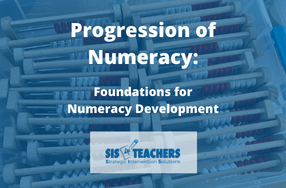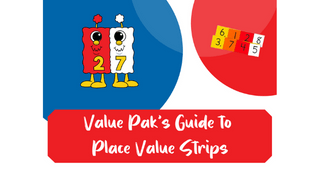We know accurate vocabulary is important, but how can I focus on integrating vocabulary into my day without feeling like I’m just adding one extra thing??
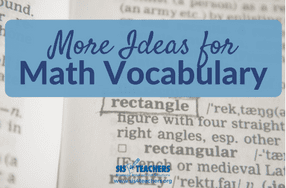 We have so many things on our instructional plate in math. Number talks, model drawings in journal, lessons, independent practice, application games, shifting from teacher led instruction to student-led. Finding time for vocabulary can seem daunting; we can’t keep adding on to our day with a whole separate time for vocabulary. But the golden rule of vocabulary is to find ways to integrate it within what we’re already doing.
We have so many things on our instructional plate in math. Number talks, model drawings in journal, lessons, independent practice, application games, shifting from teacher led instruction to student-led. Finding time for vocabulary can seem daunting; we can’t keep adding on to our day with a whole separate time for vocabulary. But the golden rule of vocabulary is to find ways to integrate it within what we’re already doing.
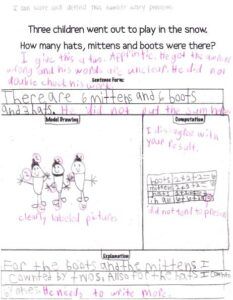
It is truly amazing to see kids and their understanding of words. We need students to not only be using these words in their speech, but also in their writing, especially in grades 2-5). Repetition is the key. You can use the word constantly and accurately in your classroom, and have expectations for it’s accurate use in the classroom instead of allowing shortcuts or abbreviations. For example, instead of saying “fourteen point six,” requiring students to say “fourteen and six tenths.” When kids say “one hundred and thirty-five” correcting them to say “one hundred thirty five” instead.
Vocabulary falls under our Math Practice 6, which is to “attend to precision.” This is one of the 21st century shifts we’re trying to make in our classrooms because it is important that students articulate their thinking correctly. When it comes time to take state tests, they need to be able to articulate their math ideas in a way that is precise and does make mathematical sense.
Here are a few easy ways to integrate vocabulary into your day!
 Math Vocabulary Cards App
Math Vocabulary Cards App
Link: https://www.mathlearningcenter.org/resources/apps/math-vocabulary-cards
This great free tool from the Math Learning Center can be put into the Math with Technology station and have students play together.
The app has a variety of terms, organized by grade level (K-2 or 3-5) and subject area within math (geometry, fractions, etc.). The vocabulary words will show either the definition or the picture/word and the students have to guess the word.
Math Vocabulary Cards is available for iOS, Chrome, and online.
Math Workshop Time
If students are done with Math by Myself, they could go on to do a vocabulary activity. They could do a foldable (like the Frayer model of a vocabulary word), or work with the Math Vocabulary Cards app. This few minutes at the end of a rotation is an excellent opportunity to add in some vocabulary time!
Power Words in Pocket Chart
Within each unit, keep a list of 7-10 (max 15) vocabulary words that go with it and create a pocket chart with those words in it, ideally the word, picture, and definition (use the Granite City Vocab Cards!). Hang the pocket chart near math salad bar so that students can be constantly be referring to them.
To encourage students to use the words, sometimes teachers will put a tally mark with a dry erase marker next to the word as they hear it being used or see it in the students’ journals. It’s amazing how much the students are motivated to use these words with this idea!
Games
Sometimes you need time to transition between one activity and the next, something fun to get them up and moving around.
 Heads Up, Seven Up (or Thumbs Up, Seven Up)
Heads Up, Seven Up (or Thumbs Up, Seven Up)
Pick four or five students to stand at the front. The lights go down, the chosen students go around and tap one other student’s head or push down one student’s thumb. When the lights come back up, the students return to the front of the class and are holding a vocabulary word. Normally, those that had their heads tapped or thumbs pushed have to say who they think did it to them. But in our Math Vocabulary version, they can’t say the student’s name or the vocabulary word they are holding. For example, Grace is holding the word parallel, and Sam thinks she tapped his head. He would have to say “I think the person that has two lines that don’t intersect tapped my head.” If he was right, Sam would switch spots with Grace for the next round. If he was not right, Sam would have to guess another vocabulary word: “Ok, so now I think it’s the person with the shape that has five sides and five angles.”
Minute to Win It
One student faces the board, the other student faces the back of the classroom. With one minute on the timer, give the students a category (ex. words you might hear in a geometry class), and then turn on the projector to show a list of vocabulary words. Students facing the board have to describe as many of them as they can to their partner, who is trying to guess without looking. “It’s a shape with three angles and three sides” “Triangle!” “Ok! This one has one face and it holds ice cream.” “It’s a cone!”
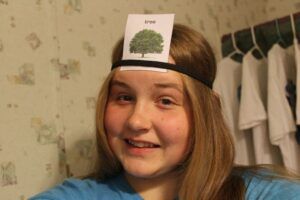 Word on your Head
Word on your Head
Students put a post-it note on their partner’s head with a math vocabulary word written on it, polygon, for example. The student with the post-it faces their group and starts asking questions about the word. “Am I a numeral?” “Am I a measurement?” “Am I a shape?” “Do I have angles?” Kids have to ask yes or no questions to determine their word.
What are ways, as you are beginning the school year, that you can integrate math vocabulary in your classroom?

